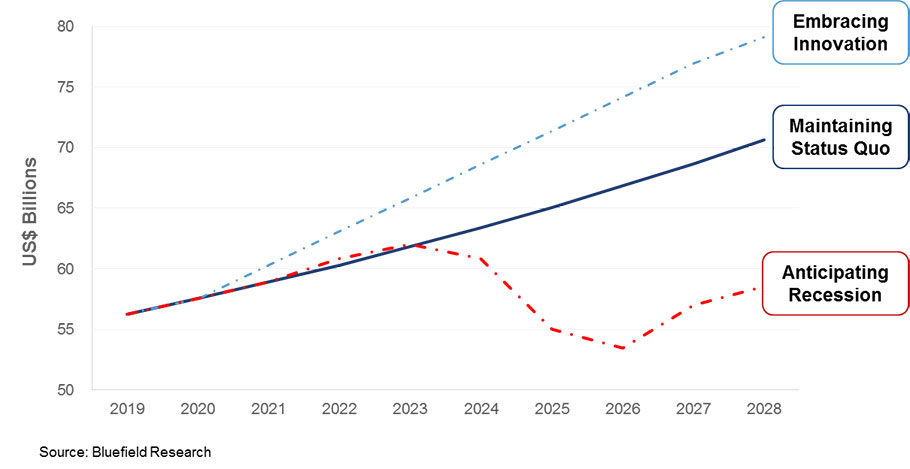Boston, Massachusetts – Municipal utilities in the U.S. are forecasted to spend US$629 billion on capital expenditures (CAPEX) over the next decade to address increasing demands on water and wastewater infrastructure. While the baseline forecast projects a 2.6% annual growth rate, in-line with historical trends, Bluefield Research’s scenario analyses highlight a potential US$107 billion swing over the ten-year forecast period.
Bluefield’s new report, Segmenting Utility CAPEX: U.S. Municipal Water Infrastructure Forecast, 2019-2028, details municipal utility CAPEX in 50 states, five U.S. territories, and Washington, D.C. It also breaks down the forecasted spending across 21 categories (e.g. plants, pipes, pumping stations) that represent the lion’s share of infrastructure investment.
“The myriad of challenges, including the deterioration of existing assets, changing demographic and industrial demands, and environmental stresses, is growing at a pace unforeseen decades ago,” says Bluefield Research Director, Erin Bonney Casey. “As such, the status quo is quickly fading as an option, if it has not already, to adequately treat, distribute and collect water & wastewater, and maintain existing assets.”
Bluefield’s Maintaining Status Quo scenario forecasts a CAPEX split between water & wastewater to be US$270 billion and US$359 billion, respectively. Within this broader spend, treatment assets (e.g. plants, systems) for both sectors combined make up 52%, or US$325 billion, of the total and pipe collection & distribution spend makes up another US$185.8 billion, or 29.5%. The remainder is spread across other smaller segments, including pumps & lift stations, storage tanks and associated network hardware (e.g. manholes, valves, hydrants, and pipe fittings).
Exhibit: Bluefield Municipal Water CAPEX Scenario Forecasting

However, a recent acceleration of concerns about water quality (e.g. lead, PFAS, algae blooms) will present increasing financial and operational risks to municipal utility stakeholders. From community leaders to customers, greater public awareness and heightened public expectations from infrastructure service providers will necessitate significant investment in advanced treatment—as opposed to linear pipe networks, as demonstrated in Bluefield’s Embracing Innovation scenario.
“Even in a mature water infrastructure sector, signals are pointing towards a crossroads,” noted Ms. Bonney Casey. “Further erosion of customer confidence in water supplies, however, should compel regulators to drive greater innovation and CAPEX on advanced treatment.”
More likely than any significant regulatory shift—beyond incremental policy changes at the state level—an economic recession would have a wider, sweeping impact on utility CAPEX. By accounting for historical impacts, including financial stimulus, Bluefield’s Anticipating Recession scenario could result in a 7.8% CAPEX decline over the next ten years. Similar to historic downturns, the impact on utility CAPEX lags several years behind the rest of the economic cycle.
“More optimistically, solutions to all of these scenarios exist, whether they be economic or technology,” Ms. Bonney Casey concludes. “Much of this falls on the public’s shoulders to hold the regulators and leaders accountable for meeting our basic infrastructure needs that are often out-of-sight, out of mind.”
About Bluefield Research
Bluefield Research provides data, analysis, and insights on global water markets. Executives rely on our water experts to validate their assumptions, address critical questions, and strengthen strategic planning processes. Bluefield works with key decision-makers at municipal utilities, engineering, procurement and construction firms, technology and equipment suppliers, and investment firms. Learn more at www.bluefieldresearch.com.

